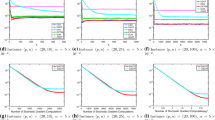Abstract
This paper studies the distributed optimization problem over an undirected connected graph subject to digital communications with a finite data rate, where each agent holds a strongly convex and smooth cost function. The agents need to cooperatively minimize the average of all agents’ cost functions. Each agent builds an encoder/decoder pair that produces transmitted messages to its neighbors with a finite-level uniform quantizer, and recovers its neighbors’ states by a recursive decoder with received quantized signals. Combining the adaptive encoder/decoder scheme with the gradient tracking method, the authors propose a distributed quantized algorithm. The authors prove that the optimization can be achieved at a linear rate, even when agents communicate at 1-bit data rate. Numerical examples are also conducted to illustrate theoretical results.
Similar content being viewed by others
References
Bertsekas D P and Tsitsiklis J N, Parallel and Distributed Computation: Numerical Methods, Prentice-Hall Englewood Cliffs, NJ, 1989, 23.
Tsitsiklis J N, Problems in decentralized decision making and computation, Massachusetts Inst. of Tech., Cambridge Lab for Information and Decision Systems, Tech. Rep., 1984.
Dong X, Hua Y, Zhou Y, et al., Theory and experiment on formation-containment control of multiple multirotor unmanned aerial vehicle systems, IEEE Transactions on Automation Science and Engineering, 2018, 16(1): 229–240.
Yi P, Hong Y, and Liu F, Initialization-free distributed algorithms for optimal resource allocation with feasibility constraints and application to economic dispatch of power systems, Automatica, 2016, 74: 259–269.
Zeng X, Yi P, and Hong Y, Distributed algorithm for robust resource allocation with polyhedral uncertain allocation parameters, Journal of Systems Science and Complexity, 2018, 31(1): 103–119.
Dörfler F, Simpson-Porco J W, and Bullo F, Breaking the hierarchy: Distributed control and economic optimality in microgrids, IEEE Transactions on Control of Network Systems, 2015, 3(3): 241–253.
Tang H, Lian X, Yan M, et al., d2: Decentralized training over decentralized data, International Conference on Machine Learning, PMLR, 2018, 4848–4856.
Gao W, Gao J, Ozbay K, et al., Reinforcement-learning-based cooperative adaptive cruise control of buses in the lincoln tunnel corridor with time-varying topology, IEEE Transactions on Intelligent Transportation Systems, 2019, 20(10): 3796–3805.
Yi P and Hong Y, Distributed cooperative optimization and its applications, Scientia Sinica Mathematica, 2016, 46(10): 1547–1564.
Yang T, Yi X, Wu J, et al., A survey of distributed optimization, Annual Reviews in Control, 2019, 47: 278–305.
Assran M, Aytekin A, Feyzmahdavian H P, et al., Advances in asynchronous parallel and distributed optimization, Proceedings of the IEEE, 2020, 108(11): 2013–2031.
Nedic A and Ozdaglar A, Distributed subgradient methods for multi-agent optimization, IEEE Transactions on Automatic Control, 2009, 54(1): 48–61.
Tsianos K I, Lawlor S, and Rabbat M G, Push-sum distributed dual averaging for convex optimization, 2012 IEEE 51st IEEE Conference on Decision and Control (CDC), IEEE, 2012, 5453–5458.
Nedić A and Olshevsky A, Distributed optimization over time-varying directed graphs, IEEE Transactions on Automatic Control, 2014, 60(3): 601–615.
Lobel I and Ozdaglar A, Distributed subgradient methods for convex optimization over random networks, IEEE Transactions on Automatic Control, 2010, 56(6): 1291–1306.
Yi P and Li L, Distributed nonsmooth convex optimization over markovian switching random networks with two step-sizes, Journal of Systems Science and Complexity, 2021, 34(4): 1324–1344.
Jakovetić D, Xavier J, and Moura J M, Fast distributed gradient methods, IEEE Transactions on Automatic Control, 2014, 59(5): 1131–1146.
Qu G and Li N, Harnessing smoothness to accelerate distributed optimization, IEEE Transactions on Control of Network Systems, 2017, 5(3): 1245–1260.
Shi W, Ling Q, Wu G, et al., Extra: An exact first-order algorithm for decentralized consensus optimization, SIAM Journal on Optimization, 2015, 25(2): 944–966.
Nedic A, Olshevsky A, and Shi W, Achieving geometric convergence for distributed optimization over time-varying graphs, SIAM Journal on Optimization, 2017, 27(4): 2597–2633.
Nedić A, Olshevsky A, Shi W, et al., Geometrically convergent distributed optimization with uncoordinated step-sizes, 2017 American Control Conference (ACC), IEEE, 2017, 3950–3955.
Pu S, Shi W, Xu J, et al., Push-pull gradient methods for distributed optimization in networks, IEEE Transactions on Automatic Control, 2020, arXiv: 1810.06653v4.
Xin R and Khan U A, A linear algorithm for optimization over directed graphs with geometric convergence, IEEE Control Systems Letters, 2018, 2(3): 315–320.
You K and Xie L, Network topology and communication data rate for consensusability of discrete-time multi-agent systems, IEEE Transactions on Automatic Control, 2011, 56(10): 2262–2275.
Tang H, Yu C, Lian X, et al., Doublesqueeze: Parallel stochastic gradient descent with double-pass error-compensated compression, International Conference on Machine Learning, PMLR, 2019, 6155–6165.
Li T, Fu M, Xie L, et al., Distributed consensus with limited communication data rate, IEEE Transactions on Automatic Control, 2010, 56(2): 279–292.
Yi P and Hong Y, Quantized subgradient algorithm and data-rate analysis for distributed optimization, IEEE Transactions on Control of Network Systems, 2014, 1(4): 380–392.
Lei J, Yi P, Shi G, et al., Distributed algorithms with finite data rates that solve linear equations, SIAM Journal on Optimization, 2020, 30(2): 1191–1222.
Kajiyama Y, Hayashi N, and Takai S, Linear convergence of consensus-based quantized optimization for smooth and strongly convex cost functions, IEEE Transactions on Automatic Control, 2020, DOI: https://doi.org/10.1109/TAC.2020.2989281.
Xiong Y, Wu L, You K, et al., Quantized distributed gradient tracking algorithm with linear convergence in directed networks, arXiv: 2104.03649, 2021.
Shi P and Nedi A, Distributed stochastic gradient tracking methods, Mathematical Programming, 2020, 187(1): 1–49.
Horn R A and Johnson C R, Matrix Analysis, Cambridge University Press, Cambridge, 2012.
Author information
Authors and Affiliations
Corresponding authors
Rights and permissions
About this article
Cite this article
Ma, X., Yi, P. & Chen, J. Distributed Gradient Tracking Methods with Finite Data Rates. J Syst Sci Complex 34, 1927–1952 (2021). https://doi.org/10.1007/s11424-021-1231-9
Received:
Published:
Issue Date:
DOI: https://doi.org/10.1007/s11424-021-1231-9




